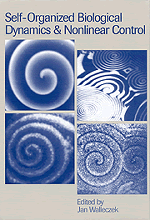 Self-Organized Biological Dynamics and Nonlinear Control
Self-Organized Biological Dynamics and Nonlinear Control Book contents
- Frontmatter
- Contents
- List of contributors
- Preface
- The frontiers and challenges of biodynamics research
- Part I Nonlinear dynamics in biology and response to stimuli
- Part II Nonlinear sensitivity of biological systems to electromagnetic stimuli
- Part III Stochastic noise-induced dynamics and transport in biological systems
- Part IV Nonlinear control of biological and other excitable systems
- 14 Controlling chaos in dynamical systems
- 15 Electromagnetic fields and biological tissues: from nonlinear response to chaos control
- 16 Epilepsy: multistability in a dynamic disease
- 17 Control and perturbation of wave propagation in excitable systems
- 18 Changing paradigms in biomedicine: implications for future research and clinical applications
- Index
16 - Epilepsy: multistability in a dynamic disease
Published online by Cambridge University Press: 14 August 2009
- Frontmatter
- Contents
- List of contributors
- Preface
- The frontiers and challenges of biodynamics research
- Part I Nonlinear dynamics in biology and response to stimuli
- Part II Nonlinear sensitivity of biological systems to electromagnetic stimuli
- Part III Stochastic noise-induced dynamics and transport in biological systems
- Part IV Nonlinear control of biological and other excitable systems
- 14 Controlling chaos in dynamical systems
- 15 Electromagnetic fields and biological tissues: from nonlinear response to chaos control
- 16 Epilepsy: multistability in a dynamic disease
- 17 Control and perturbation of wave propagation in excitable systems
- 18 Changing paradigms in biomedicine: implications for future research and clinical applications
- Index
Summary
Introduction
Suddenly the person sitting beside you falls to the ground in the grip of a generalized convulsion. Within seconds to minutes, the cataclysm ends as abruptly as it began. Why did the seizure occur when it did, and why, once started, did it stop? Even more puzzling is the centuries-old observation that a brief sensory stimulus, such as noise, given close to the onset of a seizure might have stopped it (Figure 1). The clinical challenge is to prevent seizures from occurring and, thus, to restore a normal life to the sufferer. The scientific challenge is to understand how sudden qualitative changes in brain dynamics, reflected by changes in the electroencephalogram (EEG), occur. The hope is that insights into mechanism translate into the development of effective therapeutic strategies.
A sudden change in qualitative dynamics in response to a clinical maneuver, or to a change in an endogenous factor, is the hallmark of a dynamic disease. Dynamic diseases can arise because of alterations in underlying physiological control mechanisms (Mackey and Glass, 1977; Glass and Mackey, 1979; Mackey and an der Heiden, 1982; Mackey and Milton, 1987; Milton and Mackey, 1989; Glass, 1991; Bèlair et al., 1995; Milton and Black, 1995). By analogy with mathematical models, changes of certain physiologically important parameters into critical ranges result in the sudden appearance of qualitatively different dynamical behaviors. In the mathematical models these changes in qualitative dynamics correspond to bifurcations.
- Type
- Chapter
- Information
- Self-Organized Biological Dynamics and Nonlinear ControlToward Understanding Complexity, Chaos and Emergent Function in Living Systems, pp. 374 - 386Publisher: Cambridge University PressPrint publication year: 2000
- 22
- Cited by
